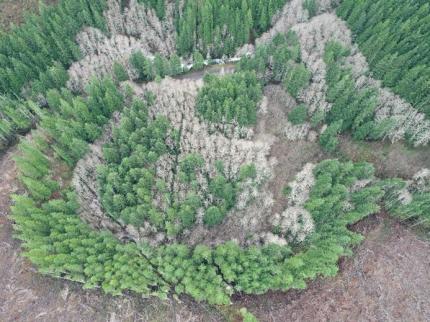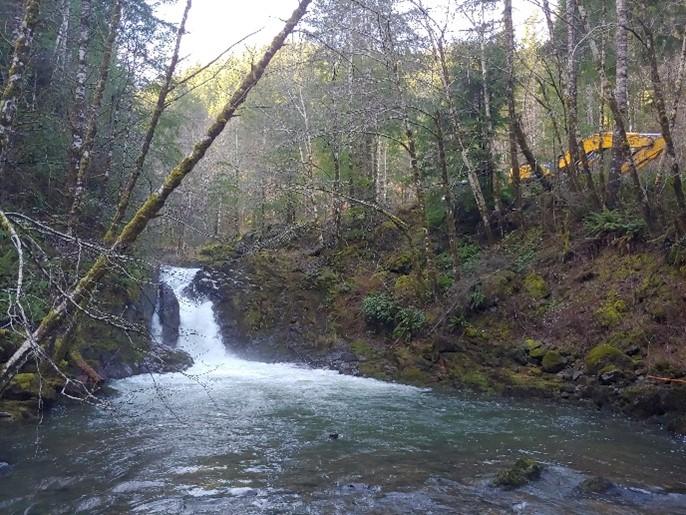Photos
Click to display full size or right-click to save to your device.
ARCHIVED NEWS RELEASE
This document is provided for archival purposes only. Archived documents
do not reflect current WDFW regulations or policy and may contain factual
inaccuracies.
News release April 6, 2021
Bob Amrine, Lewis Conservation District, 360-996-4560
CHEHALIS – Starting in summer 2021, construction will begin to remove a fish passage barrier on the West Fork Chehalis River. In partnership with Weyerhaeuser Company, Lewis Conservation District is sponsoring this river restoration project to open seven miles of previously isolated stream habitat for salmon and steelhead.
In the early 1960s, the West Fork of the Chehalis River was rechanneled as part of a forest road construction project. This human-made channel includes an impassable bedrock cascade, often referred to as the West Fork Falls fish barrier, which prevents salmon and steelhead from being able to migrate upstream.
Weyerhaeuser identified and proposed the project to remove this barrier, and the company is providing more than 50% of the funding needed to complete the work, including construction, project management, and materials. The remainder of funding comes through the Lewis Conservation District, which received funding from the Chehalis Basin Strategy’s Aquatic Species Restoration Plan 2020 grant round.

“As the project lead, Weyerhaeuser is going above and beyond what the company is required to do for fish passage,” said Bob Amrine, Lewis Conservation District Project Manager.
“Weyerhaeuser has been working to identify and repair forest road-related fish barriers and re-establish fish access across its Pacific Northwest properties since the early 1990s,” said Donald Schuh, Weyerhaeuser Forest Engineering Specialist. “This unique restoration project is a capstone for that work and part of our ongoing commitment to protecting and restoring wildlife habitat across our timberlands.”
Tribes have also voiced their support for the project. “Restoring and reconnecting access to spawning habitat is the most important action we can take to help salmon, steelhead, and lamprey survive and give them a fighting chance to someday thrive once again,” said Quinault Indian Nation Vice President Tyson Johnston. “The Quinault Nation appreciates the vision of Weyerhauser, the Lewis Conservation District, the State of Washington, and all the partners involved in this investment to create a better future for salmon in the Chehalis Basin."
The West Fork Chehalis River will be restored to its original channel by relocating the existing forest road and adding two bridges over the historical channel. The re-connected relic channel will have natural wood structures installed along the edges to create additional habitat for salmon, other fish, amphibians, and other aquatic species.
The river system above the project location supports spawning and rearing habitat currently occupied by resident trout. The channel restoration work will allow juvenile coho salmon, steelhead, and spring Chinook salmon to migrate up and downstream through this reach of the river during their early life stages.
The Washington Department of Fish and Wildlife has also documented Pacific lamprey in the West Fork of the Chehalis River, and this project will allow them to access the upper watershed. In addition, mountain whitefish, speckled dace, and reticulate sculpin are expected to use this reach of river during certain times of year.
This project represents the ongoing development of a cooperative relationship with working lands, such as commercial forestry, to enable protection of ecosystems, unique habitats, and critical ecosystem functions that are described in the Aquatic Species Restoration Plan.
About Lewis Conservation District
Lewis Conservation District provides technical, educational, and financial assistance for the conservation, protection, and development of natural resources within Lewis County.
About Weyerhaeuser Company
Weyerhaeuser Company is one of the world's largest private owners of timberlands, and one of the largest manufacturers of wood products in North America. The company began operations in 1900 and today owns or controls approximately 11 million acres of timberlands in the U.S., along with additional timberlands managed under long-term licenses in Canada. Weyerhaeuser manages these timberlands on a sustainable basis in compliance with internationally recognized forestry standards, and while conducting operations on its extensive commercial forest land base the company always seeks opportunities to protect areas that have exceptional historic, visual, recreational, forestry or wildlife habitat attributes. Learn more at www.weyerhaeuser.com.
About the Aquatic Species Restoration Plan & Chehalis Basin Strategy
To help address the downward trend of salmon runs, representatives from the Quinault Indian Nation, Confederated Tribes of the Chehalis Reservation, Washington Department of Fish and Wildlife, and other technical experts developed a science-based plan aimed at protecting and restoring aquatic habitat in the Chehalis Basin. This Aquatic Species Restoration Plan is part of the broader Chehalis Basin Strategy, an ambitious collection of potential actions designed to restore aquatic species habitat while also reducing flood-related damage in the Chehalis River basin. The Strategy includes near- and long-term actions as well as small- and large-scale projects in the state’s second-largest river drainage system.
